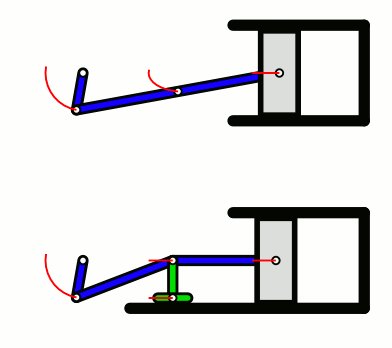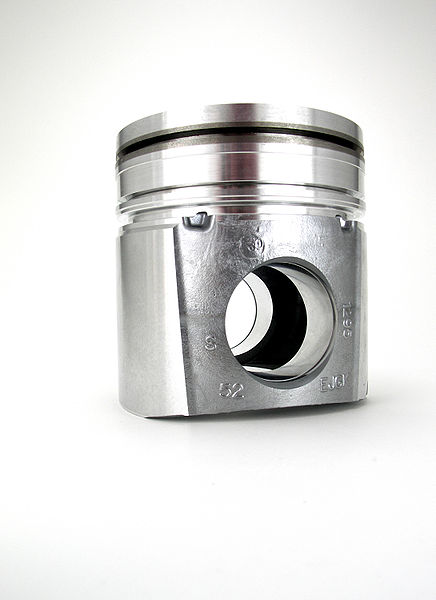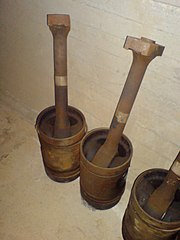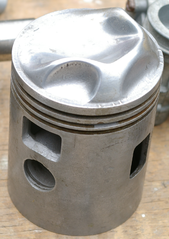My journey into engineering some 8 years ago began with my love for engines, it's parts and how they work interconnectedly, such that even before I learnt to drive a car over 2 meters i already knew all the parts of an internal combustion engine and their functions very well.
Since then I have made an effort to improve this knowledge bank about engines and this usually makes me feel that there is nothing I can see in an engine anymore that can surprise me. Well, if this particular engine that later prove me wrong had the ability to hear my assertion it would have kept its laughter until it could see the priceless look on my face when I also found out I was super wrong.
It was on a visit to one of my lecturer's office, he had a calendar on his table with the picture of different parts of the engine, my gaze however was fixed on this particular image, it looked like a piston except it appeared to have another piston under it, I couldn't help myself, so I picked up the calendar to have a closer look almost willing the image to speak up and tell me about itself.
Well it didn't, and thus necessitated the need for me to continue what I've always done whenever I see an engine feature that confuses me, I learn more about it. However, what you will find below wouldn't be just about that kind of piston but all other types of piston, their functions and how they can be maintained. I hope you find something worth adding to your knowledge.
For the sake of those who may not be very familair with engines, a piston is shown in the image above. In simple terms, it is defined by the Collins dictionary as a cylindrical fitting or metal that moves up and down in a cylinder. It further explains it's application in internal combustion engines as being the means to transfer the resulting power from gas combustion to other parts of the system for use.
It is of note here that, it is used in various applications, but this post will focus on its use in internal combustion engines.
So in technical terms, it is a component of the engine that is contained in the cylinder, moving up and down in it, its contact with the cylinder is further tightened by the piston rings which will be discussed later, it is connected to the crankshaft through the connecting rod.
A piston's upward and downward movements in a cylinder are referred to as strokes and are the basis for the stroke classification of engines.
Aluminium alloys are used for casting pistons, although earlier pistons were made from cast-iron. Also, some pistons are forged to accommodate higher fatigue.
The piston begins it work at the lowest part of the cylinder (usually referred to as the Bottom Dead Center), just before it moves up, the cylinder is supplied with the right amount of fuel and air (in applicable engine types), the piston then moves up (to the Top Dead Center) to seal the cylinder, thus forming a combustion chamber, compressing the fuel mixture in the process.
When the fuel mixture is ignited at the right time, the combustion of the fuel occurs and the resulting energy forces the piston down, the energy from this reciprocating motion is then transferred through the connecting rod to the crankshaft, hence, the crankshaft in its own rotary motion begins another process of getting the energy to where it is needed. The piston completes its work by returning to the Top Dead Center to push out the exhaust of combustion. Then the whole process is repeated numerous times for as long as the engine keeps running.
So as a summary :
The piston receives energy from the combusted fuel which it helped compress, and through its reciprocating motion transfers the energy to the crankshaft.
The piston has many parts that ensure its proper functioning. They include :
Piston crown or piston head : This is the topmost part of the piston which is exposed to the combustion chamber and is used for both the compression and the energy transfer, at such it faces a great deal of heat.
Piston pin : This is the pin that connects the piston to the connecting rod.
Skirt : It could be referred to as the wall of the piston, it is cylindrical and does the job of aligning the piston in its upward and downward movement inside the cylinder.
Ring grooves and ring lands : The grooves are the recessions into which the piston rings fit, while the lands are the parallel enclosures of the grooves.
Piston rings : A type of split ring that sits on grooves in the outer diameter of pistons. They seal the combustion chamber and scrape oil from the cylinder walls.
Here is where is my confusion about the type of piston I saw in my lecturer's office was cleared, well I wouldn't directly tell you the type I saw, but from my description of it above and the explanation I'm about to give on the types below, your ability to spot it will tell me if I've had any success with this post.
Now let's get to the types. There are four main types of piston used in Internal combustion engines. They are:
- Trunk pistons
- Crosshead Pistons
- Slipper Pistons
- Deflector Pistons
- TRUNK PISTONS : These are easily noticed due to their length as they are longer when compared to their diameter. There is a reason for this, the longer piston is to compensate for the side force of the piston side against the cylinder wall. They were originally used in Marine diesel engines, but have later been used n diesel and petrol engines alike. Their general feature is that they have an additional groove below the gudgeon pin (also known as wrist pin) for oil ring apart from the oil rings below the piston crown that are found in other piston types.
- CROSSHEAD PISTON : These are two part pistons, or you could refer to them as 2in1 pistons. There is a main piston and the smaller piston. A rod protrudes downward from the main piston to the smaller one. They are usually employed in engines where there is need for a greater compensation for the side forces.

Lower piston is a Crosshead piston from Wikimedia under CCO license
It should be noted that the main piston carries the piston rings and so does the job of sealing the cylinder for combustion while the smaller diameter cylinder does the job of mechanically guiding the main piston. More so, it is this smaller piston that holds the gudgeon pin. This piston type has a lubrication advantage over the trunk type as the oil for lubrication is not exposed to the heat of combustion and contamination.
- SLIPPER PISTONS : These types of piston were bore out of the need for improved performance of the engine, so are mostly found in high performance engines. These improvements are done by reducing their size and weight to the most possible extent. Usually the piston skirt is greatly reduced to the point where it has just enough land for the piston rings to fit in.
According to Riccardo (1922), these improvements are made to bring about a reduction in the reciprocating mass, to make balancing of the engine easier, thus permitting higher speed. He also explained that since there is a reduction in mass, there is also a reduction in inertia, which ultimately raises the mechanical efficiency of the engine. Reduced friction is also a great advantage of these types of piston.
- DEFLECTOR PISTONS : These are mainly used in two-stroke engines, the kind found in motorcycles. As explained earlier, one of the functions of the piston is to push out exhaust gases from the combustion chamber. However, for these two-stroke engines, the exhaust stroke and the intake stroke are very close to each other that if the exhaust is not properly disposed of, it could easily mix with the fresh fuel, leading to poor combustion.
To avoid this, and ensure efficient intake, the piston crown is made to have a raised rib, with this feature, the incoming fuel mixture gets deflected upwards around the combustion chamber.
To talk about pistons without specially mentioning piston rings is just like speaking of life without air. They are not just useless attachments, for without them, pistons will be much less effective, if they are even effective at all. A piston ring is a type of split ring that sits on grooves in the outer diameter of pistons. There are generally two types : the compression rings and the oil scraping rings. According to the Piston Ring Handbook (2008), they perform the following functions : 1. They seal the the combustion chamber to ensure that no gases leak to the crankcase. 2. They ensure that proper oil quantity is maintained between the cylinder wall and the piston. 3. They also improve the transfer of heat from the piston to the cylinder wall. 4. They scrape oil from the cylinder walls back to the sump.
As a bonus for following the post up to this point, here is a tip for differentiating a piston two-stroke engine piston from a four stroke engine piston.
If there are three rings on the piston, that suggests it is from a four stroke engine, while only two rings will be found on a piston from a two stroke engine.
An engine without a properly functioning piston is an engine just running the motion quite literally, as it will have very little efficiency. That being said, there are many causes of piston damage ranging from heat seizure, to poor lubrication, to improper cooling, unmixed fuels or outrightly poor fuels. All of these need to be avoided to ensure that the piston is in good condition. Also, ensure that the air filter is functioning properly.
However, the piston rings are usually the ones that need utmost maintenance, the following can be done :
- Prevent carbon residues on rings
- Ensure proper lubrication to avoid carbon deposits on the rings
- Ensure the proper functioning of your oil filter to prevent dirty oil from getting to the rings.
Usually, a worn-out or faulty piston ring is easily perceived when the engine starts giving off white smoke as exhaust. Pressure tests are also used to determine the integrity of the piston rings.
Pistons play a very important role in the functioning of the internal combustion engines, it is however one of many interconnected parts who rely on each other to produce a proper system, for the piston cannot function on it's own to produce the same work that the engine does.
Therefore, as it is very vital to know well about pistons and rightly maintain them, the same is suggested for all other parts of the Internal combustion engine.
Thank you for paying attention and following till the end. Until next time, I say farewell.
REFERENCES
Ricardo, Harry (1922). The Internal Combustion Engine. Vol I: Slow-Speed Engines (1st ed.). London: Blackie.
Piston Ring Handbook. Federal-Mogul Burscheid GmbH. August 2008.
PISTONS | PISTON RINGS | PISTON FAILURE ANALYSIS | PISTON PARTS
If you write STEM (Science, Technology, Engineering, and Mathematics) related posts, consider joining #steemSTEM on steemit chat or discord here. If you are from Nigeria, you may want to include the #stemng tag in your post. You can visit this blog by @stemng for more details.


.gif)

%20(1).jpg)

Pistons are another thing i saw at the workshop i had my industrial attachment. I never knew there are different types of pistons till i came across this.
I hope the one in the car engine isn't different from those of the diesel engine?
If they are then my imaginations have been wrong. We used the trunk piston at our workshop for those generators. Fixing a piston was a very hard thing. I still find it difficult to press the rings to make them fit into the cylinder. In case you are wondering, i repair our home generators and when it comes to cylinder problems.. I call the experts. 😂😂
Downvoting a post can decrease pending rewards and make it less visible. Common reasons:
Submit
There are different types of diesel engines, and the pistons that best serve the purpose for which an engine is designed is selected. Thank you for reading, by the way I've been following your posts and they are educating and we'll written.
Downvoting a post can decrease pending rewards and make it less visible. Common reasons:
Submit
Thank you sir.. I am doing well to follow your steps.
Downvoting a post can decrease pending rewards and make it less visible. Common reasons:
Submit
Hi sogless, I liked the article, it was written well. I think that if you put a bit of the science behind combustion it would of added more value to the post. Don't be shy to drop some comments to other users of steemstem also :)
Downvoting a post can decrease pending rewards and make it less visible. Common reasons:
Submit
All points well noted and will be worked upon. Thanks for taking the time to read.
Downvoting a post can decrease pending rewards and make it less visible. Common reasons:
Submit
Good job man. A question. If the piston is at the bottom end of the cylinder at rest or just before combustion takes place, then what makes the piston go up to compress the air-fuel mixture.
Downvoting a post can decrease pending rewards and make it less visible. Common reasons:
Submit
Remember the crankshaft carries more than one piston, therefore the firing order is so arranged to ensure that there is a piston on the power stroke every time the crankshaft rotates.
Therefore, the power from this will be used to drive the crankshaft, in the process, also moving the other pistons that are attached to the crankshaft. Thank you for reading and for asking this meaningful question. I made a little explanation about strokes in my post on Radial Engines, you may check it out to know more.
Downvoting a post can decrease pending rewards and make it less visible. Common reasons:
Submit
Being A SteemStem Member
Downvoting a post can decrease pending rewards and make it less visible. Common reasons:
Submit
What else would anyone want to know about piston? Great work @sogless.
Piston is very important to mechanical engineers and agricultural engineers.
Downvoting a post can decrease pending rewards and make it less visible. Common reasons:
Submit
Thanks for reading the post and for your encouraging comment. And I'm actually an agricultural engineer.
Downvoting a post can decrease pending rewards and make it less visible. Common reasons:
Submit
Piston. The real G in the engine.
I got refreshed here. I sure didn't know this much types of piston. We were only taught it's functions of reciprocation during my college days.
Thanks for re-educating me.
Downvoting a post can decrease pending rewards and make it less visible. Common reasons:
Submit
I'm glad you felt refreshed, curriculum are sometimes focused on particular areas of knowledge.
Downvoting a post can decrease pending rewards and make it less visible. Common reasons:
Submit